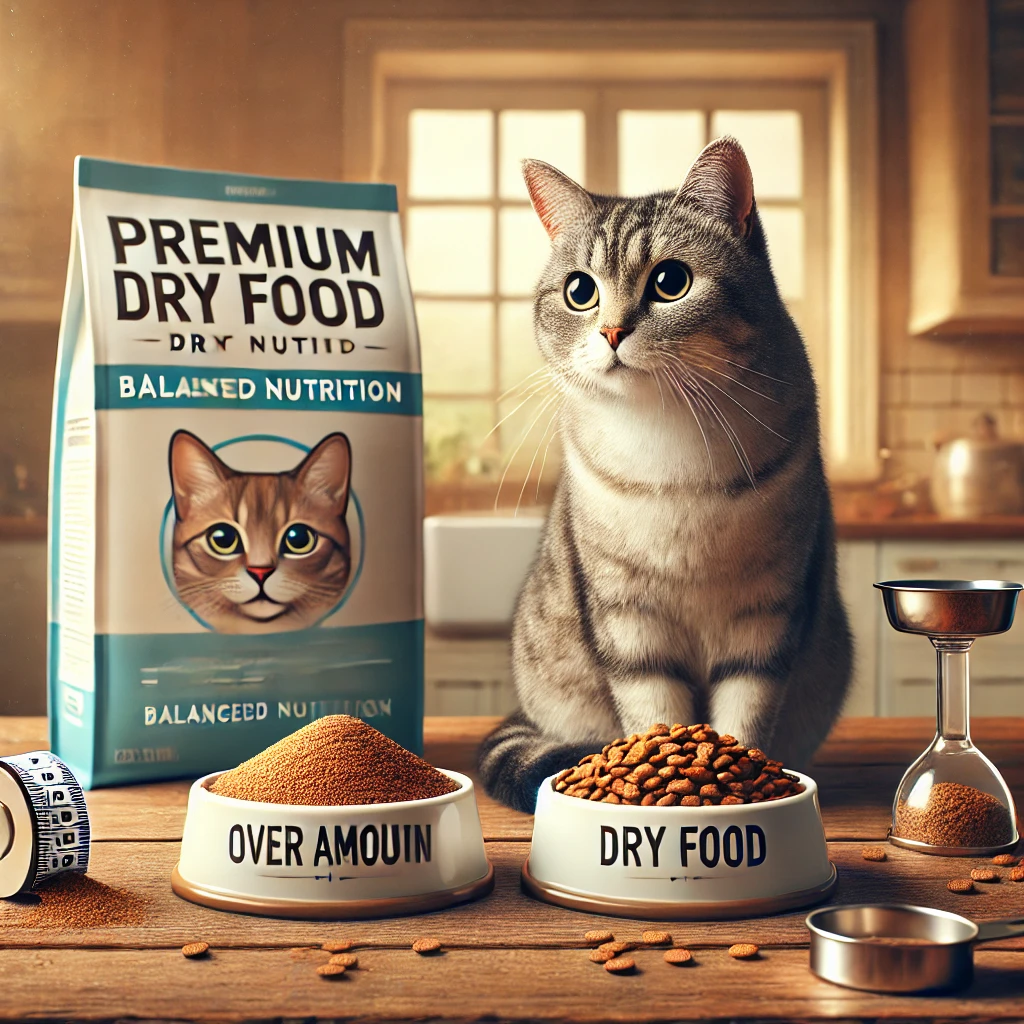Cats are creatures of habit, and feeding them the right amount of dry food each day is essential for their physical and emotional well-being. Proper portion control ensures your cat gets the necessary nutrients without the risks of overfeeding or underfeeding.
Overfeeding can lead to obesity, diabetes, and other health issues, while underfeeding may result in malnutrition, lethargy, and a weakened immune system. By carefully measuring and monitoring your cat’s food, you can support their energy levels, maintain a healthy weight, and help them thrive.
Key Factors That Affect Dry Food Portions
1. Age and Life Stages
- Kittens: Growing cats require calorie-dense food to fuel their energy needs. Divide their meals into 3-4 servings throughout the day.
- Adult Cats: Balanced portions are crucial to maintain weight and activity levels. Most adults do well with two meals per day.
- Senior Cats: Older cats often need fewer calories due to reduced activity but benefit from nutrient-rich food to support joint and immune health.
2. Activity Level
- Active cats who enjoy playing, exploring, or spending time outdoors burn more calories and may require larger portions.
- Sedentary cats, particularly those living indoors, have lower caloric needs and benefit from smaller, well-balanced portions.
3. Breed and Size
Larger breeds like Maine Coons require more food compared to smaller breeds like Siamese cats. Consider your cat’s size and body composition when determining portion sizes.
4. Health Conditions
Cats with conditions such as diabetes, kidney disease, or obesity may need specialized diets with carefully calculated portions. Always consult your vet for guidance in these cases.
Decoding Feeding Guidelines on Dry Cat Food Labels
Dry cat food packaging often includes feeding charts, but these are meant as general guidelines. Here’s how to interpret them:
1. Portion Recommendations
Feeding charts typically suggest daily portions based on your cat’s weight. Use these as a starting point and adjust for factors like activity level and age.
2. Calorie Density
Check the calorie content (kcal per cup) of the food. Higher-calorie foods require smaller portions, while lower-calorie options may need slightly larger servings.
3. Mixed Feeding
If you’re combining dry and wet food, calculate the total calorie intake and adjust portions accordingly to avoid overfeeding.
Tips for Measuring and Serving Dry Food
1. Use the Right Tools
Invest in a measuring cup or kitchen scale to serve accurate portions. Avoid estimating by eye, as this often leads to overfeeding.
2. Follow a Feeding Schedule
Divide your cat’s daily portion into 2-3 meals served at regular intervals. This helps maintain their energy levels and prevents overeating.
3. Account for Treats
Treats should make up no more than 10% of your cat’s daily calorie intake. Subtract treat calories from their main meal portions to maintain balance.
Let’s Take Guidelines of How Much Dry Food to Feed a Cat?
Choosing the Best Dry Cat Food
Not all dry cat foods are created equal. The quality of the food you choose impacts not only your cat’s health but also the portion sizes they need.
1. Look for Nutritional Value
Opt for dry food labeled as “complete and balanced” by AAFCO standards. Foods with real meat as the primary ingredient and high protein content are ideal.
2. Specialized Formulas
- Grain-Free: Good for cats with sensitivities or allergies.
- High-Protein: Supports muscle maintenance and energy needs.
- Life-Stage Specific: Choose age-appropriate formulas for kittens, adults, or seniors.
3. Trusted Brands
Reputable brands like Hill’s Science Diet, Royal Canin, and Blue Buffalo offer a variety of options tailored to specific feline needs.
Monitoring Your Cat’s Health and Adjusting Portions
Regularly observing your cat’s condition is key to ensuring they’re receiving the right amount of food. Look for these signs:
Signs of Overfeeding
- Weight gain or obesity.
- Reduced energy levels.
- Vomiting or digestive issues after meals.
Signs of Underfeeding
- Weight loss or visible ribs.
- Constant hunger or begging.
- A dull coat or reduced activity levels.
Making Adjustments
If you notice changes in your cat’s weight or behavior, gradually adjust its food portions and monitor the results. If needed, consult your veterinarian for personalized advice.
FAQs
1. How do I calculate the right amount of dry food for my cat?
Start with the feeding chart on the packaging and adjust based on your cat’s weight, activity level, and age.
2. Should I free-feed my cat dry food?
Free feeding is not recommended as it can lead to overeating and weight gain. Measured portions are a healthier choice.
3. How often should I feed my cat dry food?
Most adult cats thrive on 2 meals per day, while kittens may need 3-4 smaller meals.
4. What’s the best way to transition my cat to a new dry food?
Gradually mix the new food with the old over 7-10 days, increasing the proportion of new food daily to avoid digestive upset.
5. Is grain-free dry food better for my cat?
Grain-free options are suitable for cats with allergies or sensitivities, but not all cats require them. Consult your vet for guidance.
Conclusion
Determining the right amount of dry food for your cat is essential for its health, energy, and happiness. By considering factors like age, activity level, and health and choosing the best dry cat food, you can ensure your feline companion gets the nutrition it needs. Remember to measure portions accurately, monitor their condition, and make adjustments as needed.
